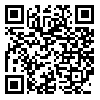جلد 13، شماره 3 - ( 6-1403 )
جلد 13 شماره 3 صفحات 25-19 |
برگشت به فهرست نسخه ها
Download citation:
BibTeX | RIS | EndNote | Medlars | ProCite | Reference Manager | RefWorks
Send citation to:



BibTeX | RIS | EndNote | Medlars | ProCite | Reference Manager | RefWorks
Send citation to:
Ostovarrad F, Dadgaran I, Tabari R, Taheri F, Peyrovi Z, Rahmanpanah S. Comparison of Caries Detection Ability among Dental Students in Two Methods of In-Person and Combined (In-Person and Virtual) Training before and during the Covid-19 Pandemic. Journal title 2024; 13 (3) :19-25
URL: http://3dj.gums.ac.ir/article-1-615-fa.html
URL: http://3dj.gums.ac.ir/article-1-615-fa.html
Comparison of Caries Detection Ability among Dental Students in Two Methods of In-Person and Combined (In-Person and Virtual) Training before and during the Covid-19 Pandemic. عنوان نشریه. 1403; 13 (3) :19-25
چکیده: (636 مشاهده)
Introduction: Since 2020, the world's educational system has been encountered with some problems due to the Covid-19 pandemic and the impossibility of holding classes. The aim of the present study was the comparison of two learning methods of in-person and combined (in-person and virtual) in caries detection ability among dental students before and during covid-19 pandemic.
Materials and Methods: This study was a cross-sectional-analytical research performed on the population of dentistry students who had passed the practical radiology courses as in-person or combined training (n=25). Ten digital bitewing radiographs were given to students to diagnose the presence/absence of caries and if there was, a diagnosis of caries depth. The students' diagnosis was recorded in a special researcher-made checklist and the answers were evaluated based on false and true. SPSS and descriptive statistics and analytical tests at the level of P<0.05 were used to analyze the data.
Results: Students in the In-person education group correctly detected the presence or absence of caries in 89% of cases, while this number was 83.75% in the group of combined education students(P<0.001). Also, students who were in the In-person education group correctly detected the depth of caries in 78.9% of cases, while this number was 70.6% in the group of combined education(P<0.050).
Conclusion: According to the findings of this study, virtual education, if it replaces In-person education, reduces the ability of students in the field of radiographic interpretation of dental caries. The use of combined and virtual education requires improving the infrastructure and reviewing traditional teaching methods.
Materials and Methods: This study was a cross-sectional-analytical research performed on the population of dentistry students who had passed the practical radiology courses as in-person or combined training (n=25). Ten digital bitewing radiographs were given to students to diagnose the presence/absence of caries and if there was, a diagnosis of caries depth. The students' diagnosis was recorded in a special researcher-made checklist and the answers were evaluated based on false and true. SPSS and descriptive statistics and analytical tests at the level of P<0.05 were used to analyze the data.
Results: Students in the In-person education group correctly detected the presence or absence of caries in 89% of cases, while this number was 83.75% in the group of combined education students(P<0.001). Also, students who were in the In-person education group correctly detected the depth of caries in 78.9% of cases, while this number was 70.6% in the group of combined education(P<0.050).
Conclusion: According to the findings of this study, virtual education, if it replaces In-person education, reduces the ability of students in the field of radiographic interpretation of dental caries. The use of combined and virtual education requires improving the infrastructure and reviewing traditional teaching methods.
| بازنشر اطلاعات | |
 | این مقاله تحت شرایط Creative Commons Attribution-NonCommercial 4.0 International License قابل بازنشر است. |

